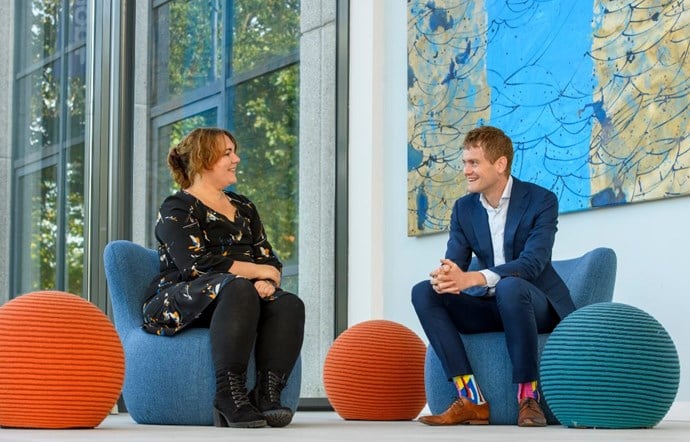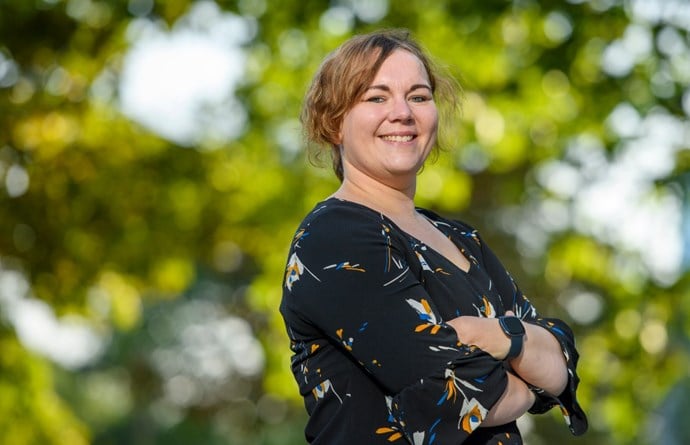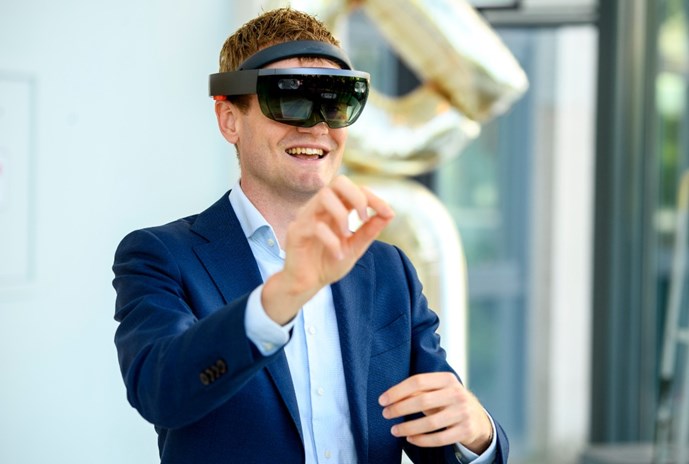Virtual learning: deeper, faster, better
Technology is rapidly improving the way we work. Using augmented reality, mixed reality and virtual reality, Kiwa is taking big strides forward in the quality, accessibility, ease and efficiency of its services – not only in audits and monitoring, but also in education and training. Eric Laan and Rianne Linthorst, two of Kiwa's experts, explain.
“At Kiwa we always strive for the best quality for the customer, with the highest efficiency and effectiveness, at the best price,” says Eric Laan, innovator at Kiwa's corporate ICT department. His aim is to help the company push the boundaries of high-quality, efficient services using innovative digital solutions. “That's why we are constantly exploring new opportunities to further improve the products and services, and add new, meaningful services using digital techniques such as IoT, big data dashboards, digital twinning, mixed reality, data mining, mobile solutions and, for example, the large-scale deployment of drones.”
Innovation in training
One of the fields where innovation is rapidly spreading is education and training. Kiwa annually offers more than 400 different courses and training programmes worldwide. On average, more than 50,000 people, from 15 countries and spread over multiple continents, participate in these training courses. Kiwa does this in various areas – from technology and quality to safety, care and energy – and for both internal and external customers, such as the large operators of gas and electricity networks. Technological innovation offers enormous opportunities to make these learning and training processes more efficient, effective and safer. In this field, Laan works closely with Rianne Linthorst, training expert and course developer at Kiwa Training in The Netherlands. Linthorst develops and designs courses, training and education methods and programmes.

Rianne Linthorst (left), training expert and course developer at Kiwa Netherlands and Eric Laan, innovator at Kiwa's corporate ICT department.
Unique new possibilities
The rise of augmented reality (AR), virtual reality (VR) and mixed reality (MR) brings new and unique possibilities. Linthorst: “These techniques enable us to introduce new ways of instruction and training. More intensive, more individual and specifically aimed at the student – so more effective. And not only that: many types of training also become much easier to perform. For example, you no longer have to travel to a training location for every training session. With simulation, you can simply do that remotely, saving lots of travel time and expense. And you can also offer digital training courses internationally quite easily.” Even more than that, virtual training gives the trainee more opportunity to learn whatever, wherever and whenever he or she wants.
AR, VR and MR: between real and virtual
Augmented reality, virtual reality and mixed reality all have their own characteristics when used in training. Linthorst: “With AR, you work in the physical world but you can ‘enrich’ it with a digital layer of information. You can work at the physical installation or machine and easily browse through maintenance manuals, watch how-to videos or follow step-by-step instructions – for example, with Microsoft Hololens or other smart glasses. MR is a step forward. You can also add virtual objects to the real environment, which you can touch, grip, move and, for example, even assemble or disassemble by hand. This is particularly useful for practising procedures that are very difficult to simulate in real life. Think of a mechanic who has to learn how to replace a part in the engine room of a large container ship on the ocean. And in both AR and VR, the instructor can remotely observe each action in real time, from any location, and can make comments and give instructions or ask questions.”

Augmented reality, virtual reality and mixed reality enable us to introduce new ways of instruction and training. More intensive, more individual and specifically aimed at the student – so more effective.Rianne Linthorst
Different characteristics
It’s a subtle but important detail: with AR and MR, you still work on location. With VR, everything is digital: the environment, the practice object, the teaching material. “This makes VR particularly suitable for practising behaviour and its effects”, says Linthorst. Think, for instance, of conversation techniques or of certain technical actions. An example from the installation sector: technicians who are used to working with natural gas systems but have to learn how to work with hydrogen installations can easily learn via VR which actions and which safety aspects will be different between the two. Working with H2 requires specific actions and safety checks that you can easily learn in virtual simulations. VR is particularly suitable for safely training a mindset and experiencing the effects of certain actions – from small to large ones.”
Digitizing H2 installations
The hydrogen example wasn’t chosen by chance: at the time of the interview (summer 2021), Linthorst was working hard on developing a series of VR training courses for hydrogen technicians. “Hydrogen is a promising energy carrier for the sustainable and renewable world of tomorrow. In the Netherlands, we have a physical Hydrogen House where technicians can practise with the new technologies, components and materials involved. By making the Hydrogen House virtual, we can also perform some of the exercises remotely and students can practise this technique as much as they want from home – eg to prepare for exams. That is convenient for them and for us: it allows us to optimally utilise the capacity of the physical Hydrogen House.”
Techniques are changing faster and faster. “And we are not only talking about changing information technology, but also about other technical fields”, Laan adds. “Think of sustainability or renewable energies. For all technicians, there is one certainty: the competences you learn in 2021 must be renewed over and over again in the coming years. There is a growing need for faster and more flexibility in learning. VR, AR and MR are the techniques Kiwa is developing to fulfil exactly that need.”

Eric Laan using a HoloLens.
Immersive learning
AR, MR and VR make learning cool, fun and impactful. Linthorst: “These new ways of immersive learning are extremely effective. You can recreate real-life environments in full detail, making this way of learning very motivating. As a student, you really feel: 'If I do this wrong, things may get nasty!' In VR you can simulate fatal errors without the real consequences, and also train disaster response. If you do something wrong – say as a surgeon or H2 installer – it is literally 'game over'. Your patient dies. Your installation explodes – including simulated short circuiting, sparks, fire and flames. Believe me, that makes quite an impression. You won't make that same mistake again – ever!”



